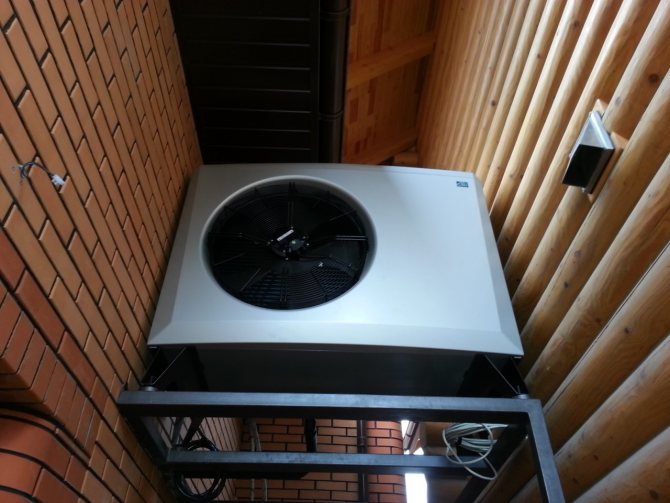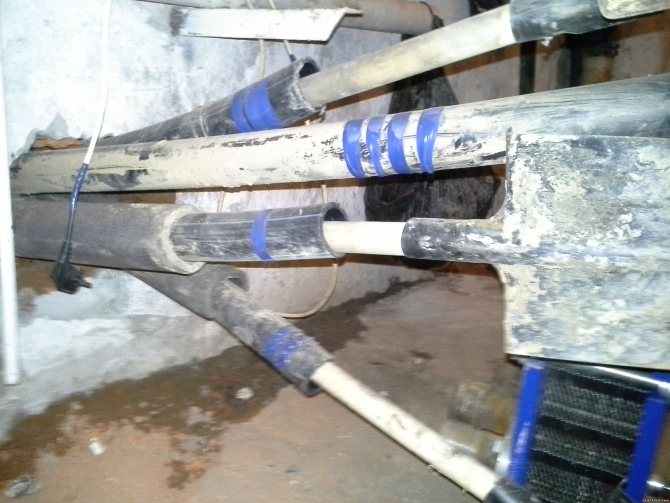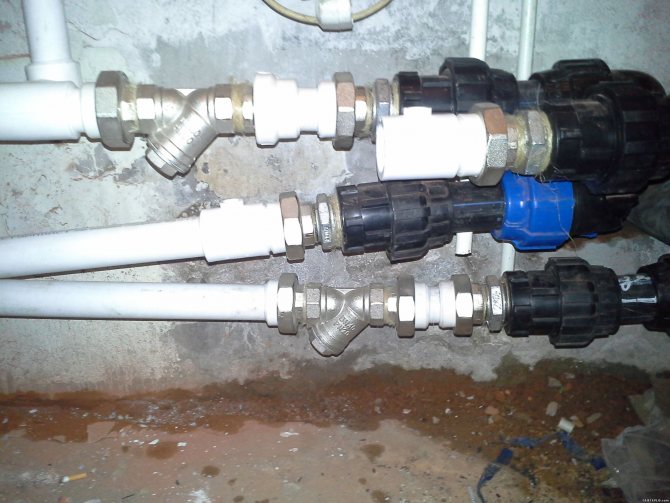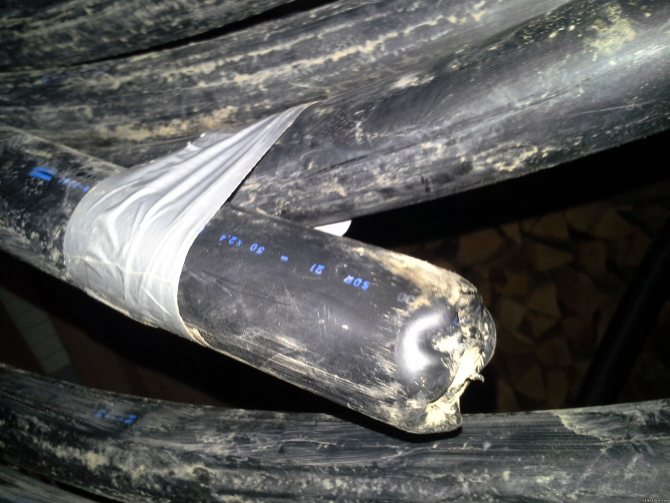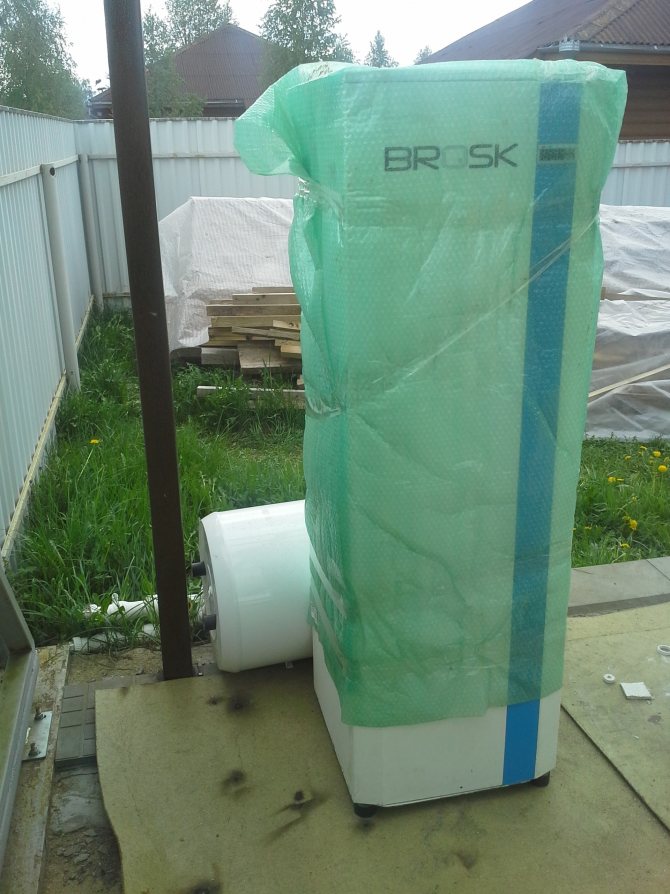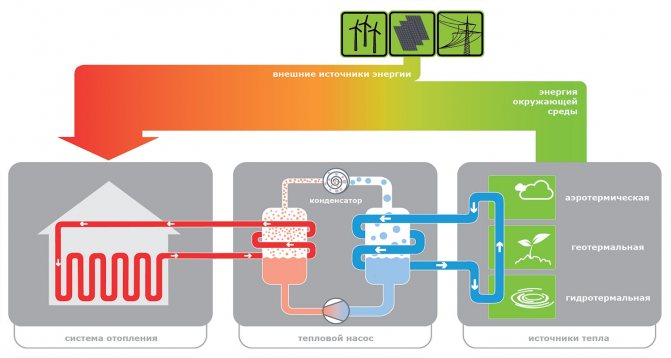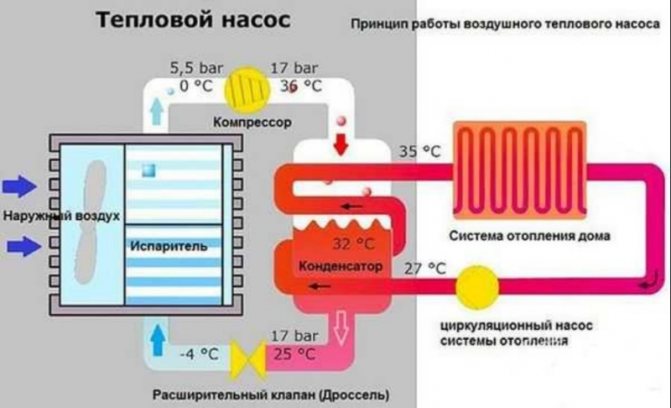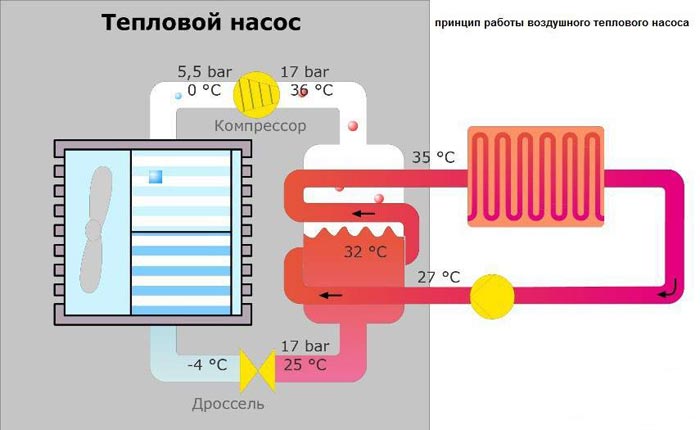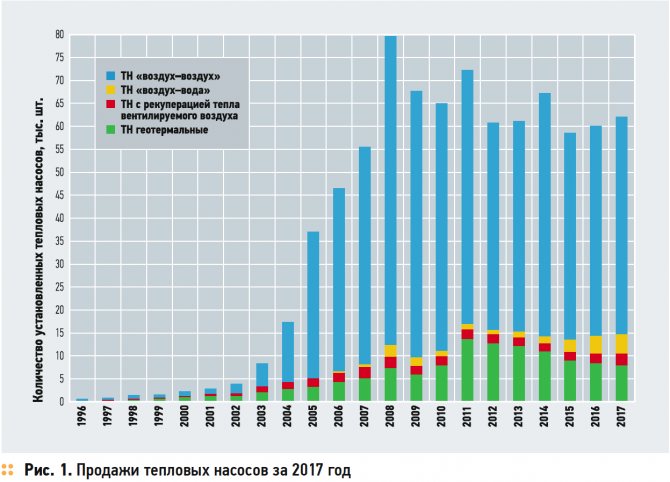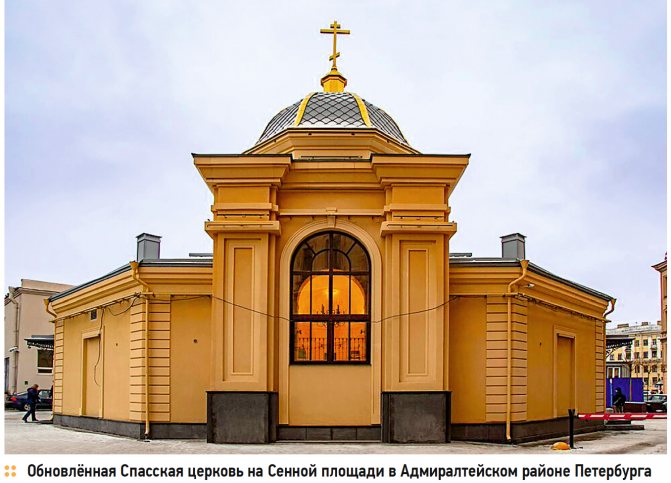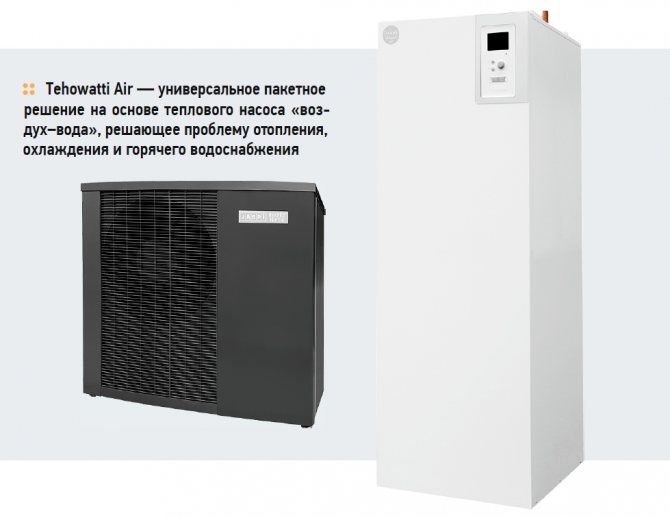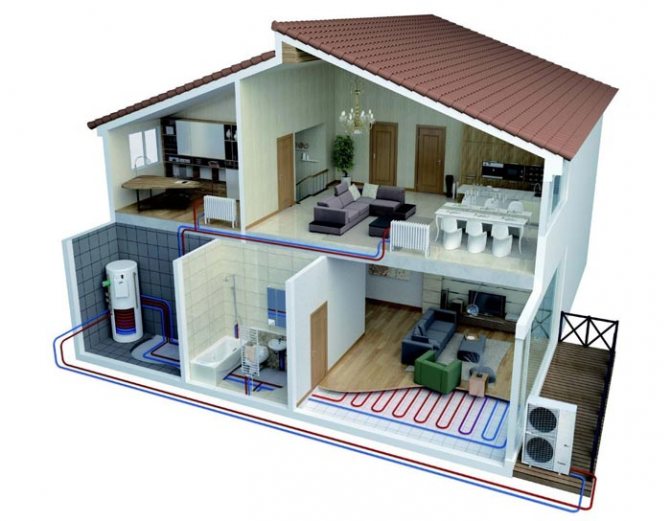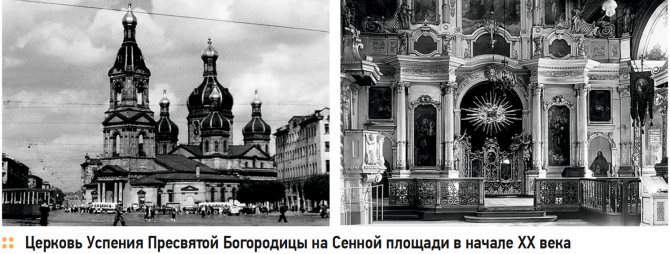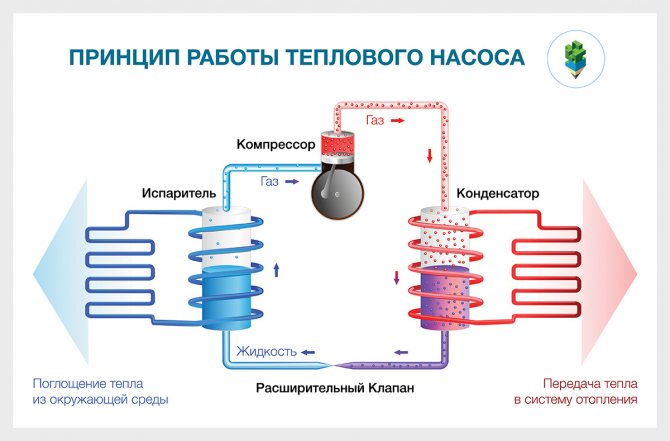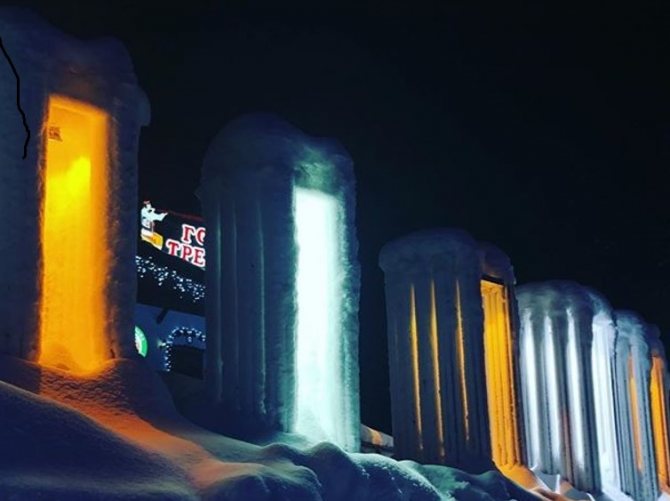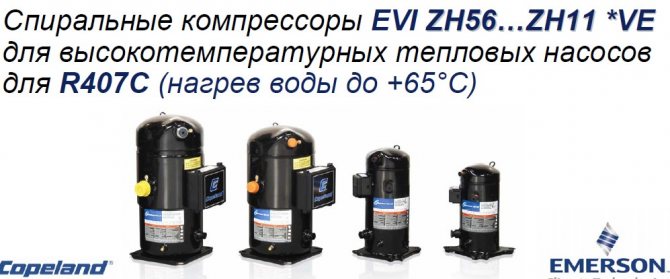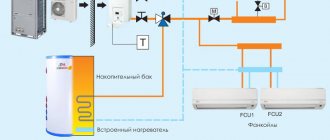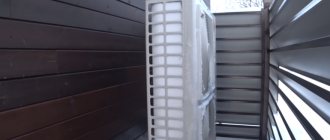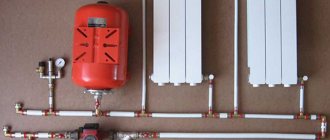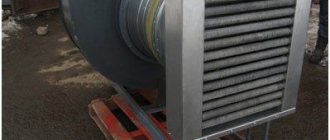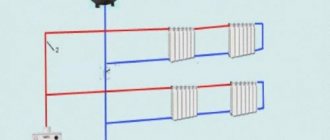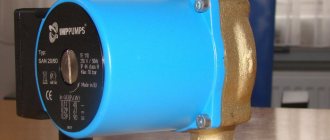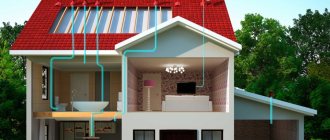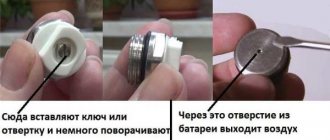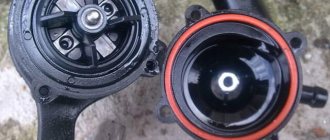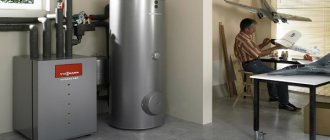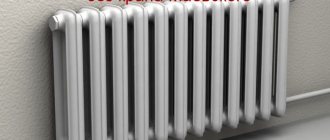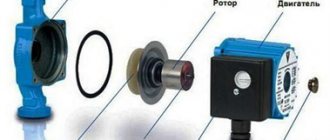Heat pump calculation example
We will select a heat pump for the heating system of a one-story house with a total area of 70 sq. m with a standard ceiling height (2.5 m), rational architecture and thermal insulation of the enclosing structures that meet the requirements of modern building codes. For heating the 1st quarter. m of such an object, according to generally accepted standards, it is necessary to spend 100 W of heat. Thus, to heat the whole house you will need:
Q = 70 x 100 = 7000 W = 7 kW of thermal energy.
We choose a heat pump of the "TeploDarom" brand (model L-024-WLC) with a thermal power of W = 7.7 kW. The compressor of the unit consumes N = 2.5 kW of electricity.
Reservoir calculation
The soil on the site allocated for the construction of the collector is clayey, the groundwater level is high (we take the calorific value p = 35 W / m).
The collector power is determined by the formula:
Qk = W - N = 7.7 - 2.5 = 5.2 kW.
Determine the length of the collector pipe:
L = 5200/35 = 148.5 m (approx).
Based on the fact that it is irrational to lay a circuit with a length of more than 100 m due to an excessively high hydraulic resistance, we accept the following: the heat pump manifold will consist of two circuits - 100 m and 50 m long.
The area of the site that will need to be allocated for the collector is determined by the formula:
S = L x A,
Where A is the step between adjacent sections of the contour. We accept: A = 0.8 m.
Then S = 150 x 0.8 = 120 sq. m.
Types and arrangement of heating systems with natural circulation
Each heating option without a pump consists of the following basic elements:
A heat source that can be represented as a boiler with various types of fuel; Expansion tank used to stabilize the pressure in the system; Coolant circulation pipelines; Radiators that heat the living space.
Depending on the type of coolant, the natural circulation system is usually divided into the following two types:
Hot water preparation; Steam heating.
Let's take a closer look at all the features of these two types of household heating systems.
Types of heat pump designs

There are the following varieties:
- ТН "air - air";
- ТН "air - water";
- TN "soil - water";
- TH "water - water".
The very first option is a conventional split system operating in heating mode. The evaporator is mounted outdoors, and a unit with a condenser is installed inside the house. The latter is blown by a fan, due to which a warm air mass is supplied to the room.
If such a system is equipped with a special heat exchanger with nozzles, the HP type "air-water" will be obtained. It is connected to a water heating system.
The HP evaporator of the "air-to-air" or "air-to-water" type can be placed not outdoors, but in the exhaust ventilation duct (it must be forced). In this case, the efficiency of the heat pump will be increased several times.
Heat pumps of the "water-to-water" and "soil-to-water" type use a so-called external heat exchanger or, as it is also called, a collector to extract heat.
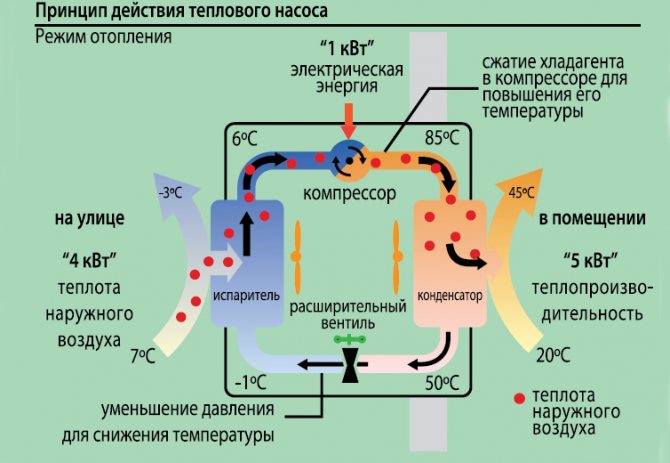

Schematic diagram of the heat pump
This is a long looped tube, usually plastic, through which a liquid medium circulates around the evaporator. Both types of heat pumps represent the same device: in one case, the collector is immersed at the bottom of a surface reservoir, and in the second - into the ground. The condenser of such a heat pump is located in a heat exchanger connected to the hot water heating system.
Connection of heat pumps according to the "water - water" scheme is much less laborious than "soil - water", since there is no need to carry out earthworks. At the bottom of the reservoir, the pipe is laid in the form of a spiral. Of course, for this scheme, only a reservoir is suitable that does not freeze to the bottom in winter.
How to choose an air-to-water heat heating pump
By choosing the right heat pump for heating an air-to-water house, you can once and for all solve the issue of heating residential and industrial premises. The selection of a suitable thermal station is carried out as follows:
- Case type - manufacturers offer two basic designs. The low-temperature monoblock air-to-water heat pump is notable for the fact that no equipment is installed in the room, all the necessary units are located outside (or in a separate isolated room). The house only includes the supply and return heating pipes. Split systems are more intended for domestic use. The external unit is installed outdoors and is connected to the storage capacity. The heated freon heats up the condenser, which, by indirect heating, transfers the heat to the liquid used as a heat carrier.
- Functionality - some models are designed to be connected only to the building's water heating system. Application of other air-to-water heat pumps, suitable for heating and hot water supply.
- Dependence of performance on ambient temperature - household models are usually limited to temperatures from + 45 ° C to -15 ° C, you can purchase equipment that can generate heat energy even at -25-32 ° C. The efficiency of a house heating system with air-water heat pump directly depends on this parameter.
In addition to the parameters when choosing, they pay attention to the capacity of the equipment, the manufacturer's company that produces the heat pump and the cost of the installation, including installation work.
How to calculate the required power of the air-water heat pump
There are two concepts, preliminary (in the first approximation) and design power calculation. The first can be done independently, the second is done by a specialized institution. As a first approximation, 70 watts of VT power are calculated for each square meter. Further calculations are performed as follows:
- Calculate the total area to be heated.
- Multiply this amount by 0.7.
- The result obtained will correspond to the minimum required power of the equipment.
To heat a house of 100 m², you need a heat pump with a capacity of 7 kW, 200 m² - 14 kW, etc.
To ensure the maximum efficiency of heating a house using an air-to-water heat pump, you will need competent project documentation and qualified installation work.
Air to water heating heat pump manufacturers
Literally 10 years ago, only a few models of heat pumps were offered on the market. Today the choice has become much greater. Leading German manufacturers, Russian, Japanese and Chinese companies, produce equipment with varying degrees of thermal efficiency.
Judging by customer reviews, the most popular are the pumps of the following companies:
- Viessmann - has been manufacturing heat pumps for over 30 years. Since then, the company's products have changed significantly. The wishes of consumers were taken into account, new technologies were introduced. TN Viessmann uses innovative automation that completely regulates the entire process of work, optimizing the heating process, in accordance with weather conditions.
- Buderus - the models are of high performance. Designed for domestic and industrial use. Fully comply with the peculiarities of domestic operation. The Buderus series offers pumps for heating areas up to 500 m² and above.
- Stiebel Eltron Is another German company that is in constant demand among domestic consumers. The advantages include a large assortment of offered equipment, functionality of devices and the ability to select according to individual requests. Stiebel Eltron models have a high COP level and are economical.
- Heliotherm - Austrian heat pumps, which have one of the best COP indicators among all thermal equipment. They have an official representative office in the Russian Federation, which greatly facilitates the installation, maintenance of systems and the fulfillment of warranty obligations. More than 15,000 different objects are equipped with Heliotherm heat pumps.
Air-to-water heat pump installation cost
The latest models of heat pumps will cost 160-1200 thousand rubles. The price varies depending on the manufacturer. The cost is strongly influenced by the "promotion" of the brand. Chinese models have a lower price, but they are also inferior in reliability and COP indicators.
Installation of air-to-water heat pumps is usually included in the price. Most manufacturers, in addition, do the project for free and provide other maintenance services. You can calculate the total cost, including the purchase of a heat pump and its installation, using online calculators.
Making a heat generator with your own hands
List of parts and accessories for creating a heat generator:
- two pressure gauges are needed to measure the pressure at the inlet and outlet of the working chamber;
- thermometer for measuring the temperature of the inlet and outlet liquid;
- valve for removing air plugs from the heating system;
- inlet and outlet branch pipes with taps;
- thermometer sleeves.
Selection of a circulating pump
To do this, you need to decide on the required parameters of the device. The first is the pump's ability to handle high temperature fluids. If this condition is neglected, the pump will quickly fail.
Next, you need to select the working pressure that the pump can create.
For a heat generator, it is enough that a pressure of 4 atmospheres is reported when the liquid enters, you can raise this indicator to 12 atmospheres, which will increase the heating rate of the liquid.
The performance of the pump will not have a significant effect on the rate of heating, since during operation the liquid passes through the conditionally narrow diameter of the nozzle. Usually up to 3-5 cubic meters of water is transported per hour. The coefficient of conversion of electricity into thermal energy will have a much greater influence on the operation of the heat generator.
Manufacturing of a cavitation chamber
But in this case, the flow of water will be reduced, which will lead to its mixing with cold masses. The small opening of the nozzle also works to increase the number of air bubbles, which increases the noise effect of the operation and can lead to the fact that bubbles begin to form already in the pump chamber. This will shorten its service life. As practice has shown, the most acceptable diameter is 9–16 mm.
In shape and profile, nozzles are cylindrical, conical and rounded. It is impossible to say unequivocally which choice will be more effective, it all depends on the rest of the installation parameters. The main thing is that the vortex process arises already at the stage of the initial entry of the liquid into the nozzle.
Natural circulation water heating
Open heating system
Heating systems without a pump are usually classified according to certain characteristics that reflect their functionality.
Depending on the type of surge tank, natural circulation heating is usually subdivided into the following types:
Open heating system. In this version, the expansion tank is positioned as high as possible to build up overpressure and allow air to be evacuated. In this case, the tank is also used to supply fluid to the system.A closed heating system with natural circulation differs in that a diaphragm accumulator is installed instead of an expansion tank, with the help of which an additional pressure of no more than 1.5 atmospheres is created. For safety reasons, the system has a built-in pressure gauge that regulates the internal pressure.
Natural circulation heating structures are also divided according to the way the heating elements are connected. According to this classification, there are the following types of heating
Monotube heating system. The principle of operation of this type of heating is that all heaters are connected in series with the system, i.e. the coolant circulates from one element to the next. The undoubted advantage of this type of heating is that its installation is quite simple and requires a minimum amount of materials. Natural circulation two-pipe heating system. In this embodiment, the heating elements are connected in parallel with the main pipe. In other words, each unit is supplied at the same temperature and the cooled liquid is returned to the boiler through a pipe, commonly referred to as a "return pipe".
This heating scheme is optimal for heating residential premises. The only drawback is that the installation of such a heating system requires a large number of pipes and other plumbing fixtures.
Building advice: When choosing a heating system for your home, you should consider your specifications when purchasing all consumables for your heating installation.
Calculation of the horizontal heat pump header
The efficiency of a horizontal collector depends on the temperature of the medium in which it is immersed, its thermal conductivity, and the area of contact with the pipe surface. The calculation method is rather complicated, therefore, in most cases, averaged data are used.
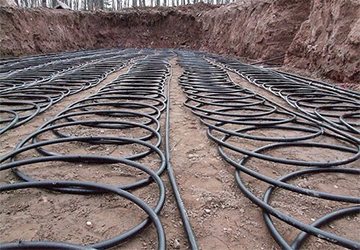

- 10 W - when buried in dry sandy or rocky soil;
- 20 W - in dry clay soil;
- 25 W - in wet clay soil;
- 35 W - in very damp clay soil.
Thus, to calculate the length of the collector (L), the required thermal power (Q) should be divided by the calorific value of the soil (p):
L = Q / p.
The values given can only be considered valid if the following conditions are met:
- The plot of land above the collector is not built-up, not shaded or planted with trees or bushes.
- The distance between adjacent turns of the spiral or sections of the "snake" is at least 0.7 m.
When calculating the collector, it should be borne in mind that the soil temperature after the first year of operation drops by several degrees.
Advantages and disadvantages of air source heat pumps
Reviews of the air water heat pump are both good and bad. After all, this device, with all the indisputable advantages, is not without some disadvantages.
Moreover, the advantages include the following facts:
Air source heat pump
- Firstly, such a unit is easy to assemble. Indeed, for the primary circuit, closed to the evaporator, neither earthworks nor reservoirs are needed.
- Secondly, air eats everywhere, but the land, in personal property, only outside the city, but with artificial or natural reservoirs, there are even more problems. Therefore, air heat pumps for heating can be installed even in urban environments without asking permission from the regulatory authorities.
- Thirdly, the air pump can be combined with the ventilation system, using the power of the unit to increase the efficiency of air exchange in the room.
In addition, such a pump operates almost silently and is easy to program.
Well, the inevitable disadvantages can be represented in the form of such a list:
- The efficiency of the unit depends on the ambient temperature. Therefore, the efficiency of the device is higher in summer than in winter.
- The air pump can only be turned on in relatively mild frosts. Moreover, at -7 degrees Celsius, the household air pump will no longer work. Although industrial units turn on at -25 degrees Celsius.
In addition, the air pump is not a completely self-contained power plant. The unit consumes electricity, transforming 1 kW / hour into 11-14 MJ.
How heat pumps work
Any heat pump has a working medium called a refrigerant. Usually freon acts in this capacity, less often ammonia. The device itself consists of only three components:
- evaporator;
- compressor;
- capacitor.
The evaporator and the condenser are two tanks that look like long curved tubes - coils. The condenser is connected at one end to the compressor outlet, and the evaporator to the inlet. The ends of the coils are joined and a pressure reducing valve is installed at the junction between them. The evaporator is in contact - directly or indirectly - with the source medium, and the condenser is in contact with the heating or DHW system.
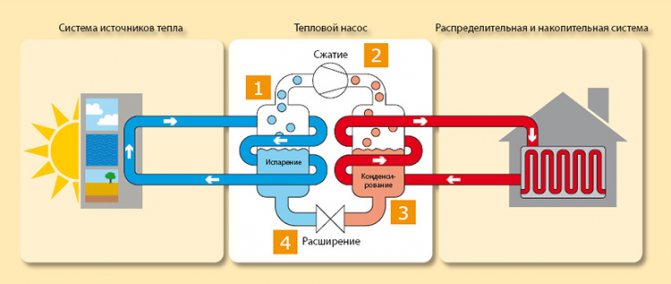

How the heat pump works
HP operation is based on the interdependence of gas volume, pressure and temperature. Here's what happens inside the unit:
- Ammonia, freon or other refrigerant, moving along the evaporator, heats up from the source medium, for example, to a temperature of +5 degrees.
- After passing through the evaporator, the gas reaches the compressor, which pumps it to the condenser.
- The refrigerant discharged by the compressor is held in the condenser by a pressure reducing valve, so its pressure is higher here than in the evaporator. As you know, with increasing pressure, the temperature of any gas increases. This is exactly what happens with the refrigerant - it heats up to 60 - 70 degrees. Since the condenser is washed by the coolant circulating in the heating system, the latter also heats up.
- The refrigerant is discharged in small portions through the pressure reducing valve to the evaporator, where its pressure drops again. The gas expands and cools down, and since part of the internal energy was lost by it as a result of heat exchange at the previous stage, its temperature drops below the initial +5 degrees. Following the evaporator, it heats up again, then it is pumped into the condenser by the compressor - and so on in a circle. Scientifically, this process is called the Carnot cycle.
The main feature of heat pumps is that thermal energy is taken from the environment literally for nothing. True, for its extraction, it is necessary to spend a certain amount of electricity (for a compressor and a circulation pump / fan).
But the heat pump still remains very profitable: for each spent kW * h of electricity, it is possible to obtain from 3 to 5 kW * h of heat.
Sources of
- https://aquagroup.ru/articles/skvazhiny-dlya-teplovyh-nasosov.html
- https://VTeple.xyz/teplovoy-nasos-voda-voda-printsip-rabotyi/
- https://6sotok-dom.com/dom/otoplenie/raschet-moshhnosti-teplovogo-nasosa.html
- https://microklimat.pro/otopitelnoe-oborudovanie/otopitelnye-pribory/teplovoj-nasos-dlya-otopleniya-doma.html
- https://avtonomnoeteplo.ru/altenergiya/148-teplovye-nasosy-voda-voda.html
- https://avtonomnoeteplo.ru/altenergiya/290-burenie-skvazhin-dlya-teplovyh-nasosov.html
- https://kotel.guru/alternativnoe-otoplenie/teplogenerator-kavitacionnyy-dlya-otopleniya-pomescheniya.html
- https://skvajina.com/teplovoy-nasos/
- https://www.burovik.ru/burenie-skvazhin-teplovye-nasosy.html
Pros and cons
The heat pump heater has a number of positive characteristics, which are reflected in the following important points:
- The production of heat energy does not require the use of different types of fuel;
- The use of a heat pump allows you to effectively heat living quarters;
- The service life is more than 25 years, which emphasizes the reliability of this type of heating system;
- The environmental friendliness of the heat pump lies in the fact that there are absolutely no emissions into the atmosphere;
- During warmer months, this unit can be used as an air conditioner;
- easy control of the heat pump;
- can be used in combination with other renewable energy equipment.
Heat pumps of the "air-to-water" type have a significant drawback - they are relatively high price, which does not allow for widespread use of this type of heating.
Therefore, it is very important to calculate in advance the power of the heat pump for heating the house in order to calculate the efficiency of the heating system using the heat pump.
Features of wells for heat pumps
The main element in the operation of the heating system when using this method is the well. Its drilling is carried out in order to install a special geothermal probe and a heat pump directly in it.
The organization of a heating system based on a heat pump is rational both for small private cottages and for whole farmlands. Regardless of the area that will need to be heated, an assessment of the geological section in the site should be carried out before drilling wells. Accurate data will help to correctly calculate the number of required wells.
The depth of the well should be selected in such a way that it can not only provide sufficient heat to the object under consideration, but also allow the selection of a heat pump with standard technical characteristics. To increase heat transfer, a special solution is poured into the cavity of the wells where the built-in circuit is located (as an alternative to the solution, clay can be used).
The main requirement for drilling wells for heat pumps is complete isolation of all, without exception, groundwater horizons. Otherwise, the ingress of water into the underlying horizons can be regarded as pollution. If the coolant gets into groundwater, it will have negative environmental consequences.
Prices for drilling wells for heat pumps
The cost of installing the first circuit of geothermal heating
| 1 | Drilling wells in soft rocks | 1 r.m. | 600 |
| 2 | Drilling wells in hard rocks (limestone) | 1 r.m. | 900 |
| 3 | Installation (lowering) of the geothermal probe) | 1 r.m. | 100 |
| 4 | Pressing and filling the outer contour | 1 r.m. | 50 |
| 5 | Borehole backfill to improve heat transfer (granite screening) | 1 r.m. | 50 |
Why did I choose a heat pump for my home heating and water supply system?
So, I bought a plot to build a house without gas. The prospect of gas supply is in 4 years. It was necessary to decide how to live up to this time.
The following options were considered:
- 1) gas tank 2) diesel fuel 3) pellets
The costs for all these types of heating are commensurate, so I decided to make a detailed calculation using the example of a gas tank. The considerations were as follows: 4 years on imported liquefied gas, then replacing the nozzle in the boiler, supplying the main gas and a minimum of costs for rework. The result is:
- for a house of 250 m2, the cost of a boiler, a gas tank is about 500,000 rubles
- the entire site needs to be dug
- availability of a convenient access for a refueller for the future
- maintenance of about 100,000 rubles per year:
- the house will have heating + hot water
- at a temperature of -150 ° C and below, the costs are 15-20,000 rubles per month).
Total:
- gas tank + boiler - 500,000 rubles
- operation for 4 years - 400,000 rubles
- supply of the main gas pipe to the site - 350,000 rubles
- replacement of the nozzle, boiler maintenance - 40,000 rubles
In total - 1 250 000 rubles and a lot of fuss around the issue of heating in the next 4 years! Personal time in terms of money is also a decent amount.
Therefore, my choice fell on a heat pump with commensurate costs for drilling 3 wells of 85 meters each and purchasing it with installation. Heat pump Buderus 14 kW has been in operation for 2 years. A year ago I installed a separate meter for it: 12,000 kWh per year !!! In terms of money: 2400 rubles per month! (The monthly payment for gas would be more) Heating, hot water and free air conditioning in the summer!
Air conditioning works by raising the coolant at a temperature of + 6-8 ° C from the wells, which is used to cool the premises through conventional fan coil units (a radiator with a fan and a temperature sensor).
Conventional air conditioners are also very energy-intensive - at least 3 kW per room. That is, 9-12 kW for the whole house! This difference must also be taken into account in the payback of the heat pump.
So the payback in 5-10 years is a myth for those who sit on the gas pipe, the rest are welcome to the club of “Green” energy consumers.
Installation nuances
When choosing a water-to-water heat pump, it is important to calculate the operating conditions. If the line is immersed in a body of water, you need to take into account its volume (for a closed lake, pond, etc.), and when installed in a river, the speed of the current
If miscalculated, the pipes will freeze with ice and the efficiency of the heat pump will be zero.
What is a chiller and how does it work
When sampling groundwater, seasonal fluctuations must be taken into account. As you know, in spring and autumn, the amount of groundwater is higher than in winter and summer. Namely, the main operating time of the heat pump will be in the winter. To pump out and pump water, you need to use a conventional pump, which also consumes electricity. Its costs should be included in the total and only after that the efficiency and payback period of the heat pump should be considered.
a great option is to use artesian water. It comes out of deep layers by gravity, under pressure. But you will have to install additional equipment to compensate for it. Otherwise, the components of the heat pump may be damaged.
The only disadvantage of using an artesian well is the cost of drilling. The costs will not pay off soon due to the lack of a pump for lifting water from a conventional well and pumping it into the ground.
Installation features
Since air / water heating with a heat pump is a complex technical device, it is best to outsource the installation to highly qualified specialists.
If you decide to equip the system with your own hands, you first need to correctly calculate the installation time of heating using a heat pump.
The stages of any type of installation can be defined:
- Preparatory work is estimated in 1-2 weeks;
- Installation of an external heat pump system - 3-7 days;
- Indoor unit equipment and heating system installation - 1-2 weeks;
- Commissioning and debugging - 2-3 days.
It is also important to remember that when installing a heat pump, it is necessary to take into account the specifics of the installation, which may include the following points:
- The external heat pump unit is installed near a residential area at a distance of 2 to 10 meters.
- It is recommended to install a protective space above the outdoor unit to protect it from environmental influences.
- The installation site must be well ventilated and far away from open flames.
- The pump must be installed on a solid metal base.
- All pipe connections of the heat pump must be of sufficient quality, which is achieved by twisting the ends of the pipes.
- The heating system must be installed taking into account that the temperature of the heating medium will not be very high.
Technical Committee: Underfloor heating is the best option for heating with an air-to-water heat pump.
We have taken into account all the features and characteristics of the air-water heat pump. Based on all this, it is safe to say that such a heating system is an economical and efficient heat carrier, which will soon attract sufficient attention.
Watch a video showing the operation of an air-to-water heat pump and feedback from owners and experts:
Page 2
After building a country house or summer cottage, everyone thinks about how to heat their house as efficiently as possible. Today there are many types of heaters and it is sometimes very difficult to choose one type of heating or another.
When designing a heating system, it is strongly recommended to use a natural circulation heat pump. In order to understand the essence of the issue, we will describe in more detail this type of space heating, indicate its various characteristics, and also tell you about the installation of the system.
Heating heat generator operation technology
In the working body, the water must receive an increased speed and pressure, which is carried out using pipes of various diameters, tapering along the flow. In the center of the working chamber, several pressure flows are mixed, leading to the phenomenon of cavitation.
In order to control the speed characteristics of the water flow, braking devices are installed at the outlet and in the course of the working cavity.
The water moves to the nozzle at the opposite end of the chamber, from where it flows in the return direction for reuse using a circulating pump. Heating and heat generation occurs due to the movement and sharp expansion of the liquid at the exit from the narrow orifice of the nozzle.
Positive and negative properties of heat generators
Cavitation pumps are classified as simple devices. They convert the mechanical motor energy of water into thermal energy, which is spent on heating the room. Before building a cavitation unit with your own hands, it should be noted the pros and cons of such an installation. Positive characteristics include:
- efficient generation of heat energy;
- economical in operation due to the lack of fuel as such;
- an affordable option for purchasing and making it yourself.
Heat generators have disadvantages:
- noisy pump operation and cavitation phenomena;
- materials for production are not always easy to get;
- uses a decent capacity for a room of 60–80 m2;
- takes up a lot of usable room space.
Well drilling for heat pump system
It is better to entrust the well device to a professional installation organization. It is optimal for representatives of the company selling the heat pump to do this. So, you can take into account all the nuances of drilling and the location of the probes from the structure, and fulfill other requirements.
A specialized organization will assist in obtaining a permit for drilling a well for probes for a ground source heat pump. According to the legislation, the use of groundwater for economic purposes is prohibited. We are talking about the use for any purpose of waters located below the first aquifer.
As a rule, the procedure for drilling vertical systems should be coordinated with the state administration authorities. Lack of permits leads to penalties.
After receiving all the necessary documents, installation work begins, according to the following order:
- The drilling points and the location of the probes on the site are determined, taking into account the distance from the building, landscape features, the presence of groundwater, etc. Maintain a minimum gap between the wells and the house of at least 3 m.
- Drilling equipment is being imported, as well as equipment necessary for landscape work. For vertical and horizontal installation, a drill and jackhammer is required. For drilling the soil at an angle, drilling rigs with a fan contour are used. The greatest application was received by the model operating on a caterpillar track. Probes are placed in the resulting wells and the gaps are filled with special solutions.
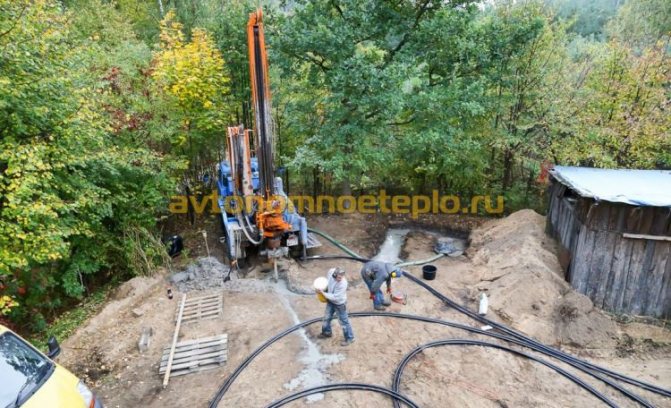

Drilling wells for heat pumps (with the exception of cluster wiring) is allowed at a distance of at least 3 m from the building. The maximum distance to the house should not exceed 100 m. The project is carried out on the basis of these standards.
What depth of the well should be
Depth is calculated based on several factors:
- The dependence of efficiency on the depth of the well - there is such a thing as an annual decrease in heat transfer.If the well has a great depth, and in some cases it is required to make a channel up to 150 m, every year there will be a decrease in the indicators of the received heat, over time the process will stabilize. Making a well of maximum depth is not the best solution. Usually, several vertical channels are made, distant from each other. The distance between the wells is 1-1.5 m.
- The calculation of the depth of drilling a well for probes is carried out taking into account the following: the total area of the adjacent territory, the presence of groundwater and artesian wells, the total heated area. So, for example, the depth of drilling wells with high groundwater is sharply reduced in comparison with the manufacture of wells in sandy soil.
The creation of geothermal wells is a complex technical process. All work, from the design documentation to the commissioning of the heat pump, must be performed exclusively by specialists.
To calculate the approximate cost of work, use online calculators. The programs help to calculate the volume of water in the well (affects the amount of required propylene glycol), its depth and perform other calculations.
How to fill the well
The choice of materials often rests entirely with the owners themselves.
The contractor may advise you to pay attention to the type of pipe and recommend the composition for filling the well, but the final decision will have to be made independently. What are the options?
- Pipes used for wells - use plastic and metal contours. Practice has shown that the second option is more acceptable. The service life of a metal pipe is at least 50-70 years, the walls of the metal have good thermal conductivity, which increases the efficiency of the collector. Plastic is easier to install, so construction organizations often offer just it.
- Material for filling gaps between pipe and ground. Well plugging is a mandatory rule to be performed. If the space between the pipe and the ground is not filled, shrinkage occurs over time, which can damage the integrity of the circuit. The gaps are filled with any building material with good thermal conductivity and elasticity, such as Betonit. Filling the well for the heat pump should not impede the normal circulation of heat from the ground to the collector. The work is done slowly so as not to leave voids.
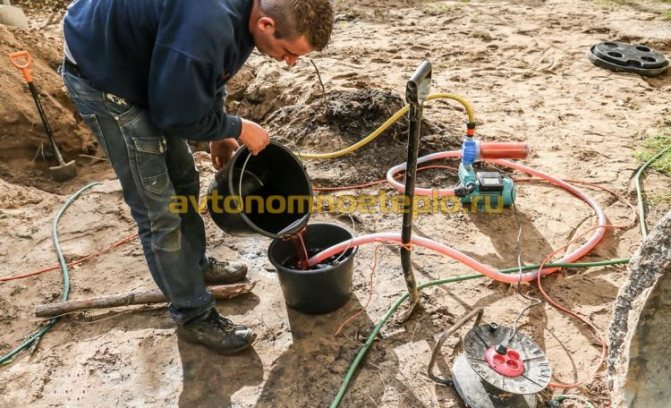

Even if the drilling and positioning of the probes from the building and from each other is done correctly, after a year, additional work will be required due to the shrinkage of the collector.

